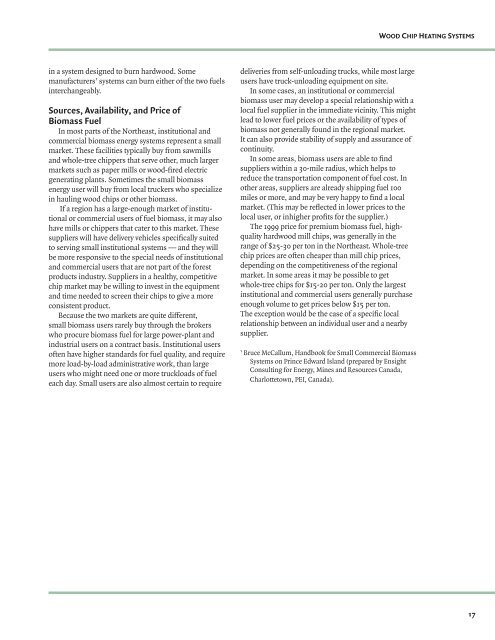Wood-Chip Heating Systems - Biomass Energy Resource Center
Wood-Chip Heating Systems - Biomass Energy Resource Center
Wood-Chip Heating Systems - Biomass Energy Resource Center
You also want an ePaper? Increase the reach of your titles
YUMPU automatically turns print PDFs into web optimized ePapers that Google loves.
in a system designed to burn hardwood. Some<br />
manufacturers’ systems can burn either of the two fuels<br />
interchangeably.<br />
Sources, Availability, and Price of<br />
<strong>Biomass</strong> Fuel<br />
In most parts of the Northeast, institutional and<br />
commercial biomass energy systems represent a small<br />
market. These facilities typically buy from sawmills<br />
and whole-tree chippers that serve other, much larger<br />
markets such as paper mills or wood-fi red electric<br />
generating plants. Sometimes the small biomass<br />
energy user will buy from local truckers who specialize<br />
in hauling wood chips or other biomass.<br />
If a region has a large-enough market of institutional<br />
or commercial users of fuel biomass, it may also<br />
have mills or chippers that cater to this market. These<br />
suppliers will have delivery vehicles specifi cally suited<br />
to serving small institutional systems — and they will<br />
be more responsive to the special needs of institutional<br />
and commercial users that are not part of the forest<br />
products industry. Suppliers in a healthy, competitive<br />
chip market may be willing to invest in the equipment<br />
and time needed to screen their chips to give a more<br />
consistent product.<br />
Because the two markets are quite different,<br />
small biomass users rarely buy through the brokers<br />
who procure biomass fuel for large power-plant and<br />
industrial users on a contract basis. Institutional users<br />
often have higher standards for fuel quality, and require<br />
more load-by-load administrative work, than large<br />
users who might need one or more truckloads of fuel<br />
each day. Small users are also almost certain to require<br />
deliveries from self-unloading trucks, while most large<br />
users have truck-unloading equipment on site.<br />
In some cases, an institutional or commercial<br />
biomass user may develop a special relationship with a<br />
local fuel supplier in the immediate vicinity. This might<br />
lead to lower fuel prices or the availability of types of<br />
biomass not generally found in the regional market.<br />
It can also provide stability of supply and assurance of<br />
continuity.<br />
In some areas, biomass users are able to fi nd<br />
suppliers within a 30-mile radius, which helps to<br />
reduce the transportation component of fuel cost. In<br />
other areas, suppliers are already shipping fuel 100<br />
miles or more, and may be very happy to fi nd a local<br />
market. (This may be refl ected in lower prices to the<br />
local user, or inhigher profi ts for the supplier.)<br />
The 1999 price for premium biomass fuel, highquality<br />
hardwood mill chips, was generally in the<br />
range of $25-30 per ton in the Northeast. Whole-tree<br />
chip prices are often cheaper than mill chip prices,<br />
depending on the competitiveness of the regional<br />
market. In some areas it may be possible to get<br />
whole-tree chips for $15-20 per ton. Only the largest<br />
institutional and commercial users generally purchase<br />
enough volume to get prices below $15 per ton.<br />
The exception would be the case of a specifi c local<br />
relationship between an individual user and a nearby<br />
supplier.<br />
1 Bruce McCallum, Handbook for Small Commercial <strong>Biomass</strong><br />
<strong>Systems</strong> on Prince Edward Island (prepared by Ensight<br />
Consulting for <strong>Energy</strong>, Mines and <strong>Resource</strong>s Canada,<br />
Charlottetown, PEI, Canada).<br />
WOOD CHIP HEATING SYSTEMS<br />
17





